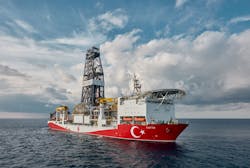In the last two years Turkish Petroleum (TPAO) has discovered 540 bcm of gas in the western Black Sea. The drillship Fatih drilled the ultra-deepwater Sakarya and Amasra discovery wells. With estimated in-place volumes of 405 bcm, Sakarya is said to be the largest ever hydrocarbon discovery in the Black Sea and for the country.
Ashley Sherman, principal analyst, Europe upstream at Wood Mackenzie, said: “It was always likely that Turkey’s Black Sea resource estimates would grow thanks to continued appraisal of the giant Sakarya discovery and new exploration wells by Turkey’s own drillships. Optimistically, if 100% were recovered, that’s equivalent to around 12 years of Turkey’s current, overwhelmingly import-dominated, gas demand,” he added. “The strategic focus now needs to shift even more from adding resources to developing the volumes already discovered. That means consistent progress offshore – with wells and pipelines – and onshore at the gas plant site at Filyos.”
According to Sherman, TPAO’s exploration successes have also strengthened Turkey’s negotiating position concerning its gas imports from Azerbaijan, Iran, and Russia, giving the country greater leverage to push for lower prices, lower volumes, and improved contract flexibility.
“It’s already true in current talks with as close a partner as Azerbaijan, for a long-term contract that expired in April and is still yet to be renewed,” Sherman said.
In October, the Turkish state oil company awarded the Subsea 7 and Schlumberger consortium an EPCI contract for the Sakarya gas field development. The full scope covers subsurface equipment to onshore production, including well completions, subsea production systems, subsea umbilicals, risers and flowlines, and an early production facility (EPF).
Schlumberger will manage the well completions scope, along with design, construction, and commissioning of the EPF to handle up to 350 MMcf/d of gas.
Subsea 7’s EPCI responsibilities cover the subsea pipelines and associated equipment to connect the wells, in around 2,000 m (6,562 ft) water depth, to the EPF. It will also supply and install the infield flowlines, control umbilicals, tie-in connections, associated subsea equipment, the 170 km (105.6 mi) of gas export pipeline, and the monoethylene glycol injection pipeline to the EPF.
Olivier Blaringhem, CEO of Subsea Integration Alliance, said: “A strong, collaborative early engagement process led by Turkish Petroleum has enabled an industry-leading timeline from discovery to first gas for a project of this scale and complexity.”
Project management and engineering has started and will be managed from the Subsea 7 office in Istanbul, Turkey. First gas is planned for 2023.
Saipem will transport and install the pipelines, with most of the operations performed by the pipelay vessel Castorone. Offshore operations are due to start next spring.
Also, TPAO has appointed Wood as the integrated project management partner. Wood’s multi-disciplinary team will perform integrated project management and engineering verification for the first EPCI phase of the project. This includes engineering, procurement, and installation of the subsea production system, gas transport pipeline and umbilical, and the onshore processing facility in Filyos.
Over the past year, Wood’s subsea team supported the company through the pre-FEED and FEED phases.
To the north, Black Sea Oil & Gas (BSOG), Petro Ventures Resources SRL, and Gas Plus Dacia SRL are developing Romania’s first new offshore project in more than 30 years. The Midia Gas Development (MGD) project consists of the Ana and Doina gas fields. It will have five production wells – one subsea well at the Doina field and four platform wells at the Ana field. A subsea gas production system over the Doina well will connect through an 18-km (11-mi) pipeline to an unmanned wellhead platform over Ana.
A 126-km (78-mi) gas pipeline will link the Ana platform to the shore and to a new onshore gas treatment plant in Corbu commune, Constanta county. With a capacity of 1 bcm/yr, this represents 10% of Romania’s consumption. The processed gas will be delivered into the National Transmission System at the gas metering station in the gas treatment plant.
Romanian company Grup Servicii Petroliere (GSP) is responsible for the entire project infrastructure, offshore and onshore. In September, the crane barge GSP Neptun installed the Ana platform topsides in 70 m (230 ft) of water.
According to operator BSOG, the $400-million MGD project is 70% complete. First gas is expected next year.
BSOG CEO Mark Beacom said the project “demonstrates the unique opportunity that Romania alone has in the EU to become self-sufficient in gas and thereby reduce its increasingly growing reliance on imported gas from foreign counties.”
Romanian gas distributor S.N.G.N. Romgaz is expected to pay more than $1 billion to acquire ExxonMobil Exploration and Production Romania Ltd. The latter holds 50% of the rights and obligations under the concession agreement for the XIX Neptun Deep block in the Romanian Black Sea. The other 50% is held by OMV Petrom.
In October, Romgaz and ExxonMobil finalized exclusive negotiations and reached an agreement on the terms and conditions for the acquisition. Upon completion of the transaction, OMV Petrom will become operator. Subject to approvals, the transaction is expected to be completed in 1Q 2022.
Romgaz and OMV Petrom are looking to jointly develop the Neptun Deep block, which includes the deepwater Domino gas discovery.
Christina Verchere, CEO of OMV Petrom, said: “The Black Sea is a unique opportunity for Romania, and we are committed to contributing to its materialization. OMV Petrom has over 40 years of offshore experience as operator in the Black Sea.”
Aristotel Jude, general manager of Romgaz, added: “We are ready to act as equal partners to make this strategic project happen.”
In 2008, ExxonMobil and OMV Petrom formed a joint venture to explore the concession which covers 7,500 sq km (2,896 sq mi), in water depths of 100-1,700 m (328-5,577 ft). Over the next eight years the partners spent $1.5 billion on exploration and appraisal activities, including two campaigns during which eight wells were drilled. In 2012, the Domino-1 proved gas for the first time in Romania’s deepwater sector. Most of the seven follow-up wells also encountered gas.
Finally, OMV Petrom has signed the production sharing contract for the offshore block II in the exclusive economic zone of the Georgian Black Sea. The block covers a total area of 5,282 sq km (2,039 sq mi) and the water depth varies between 400 and 2,000 m (1,312 and 6,562 ft). The company is preparing for a large 3D seismic campaign in 2022.





